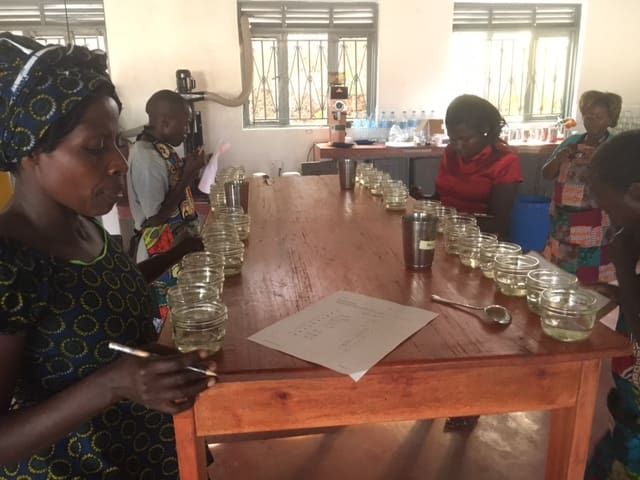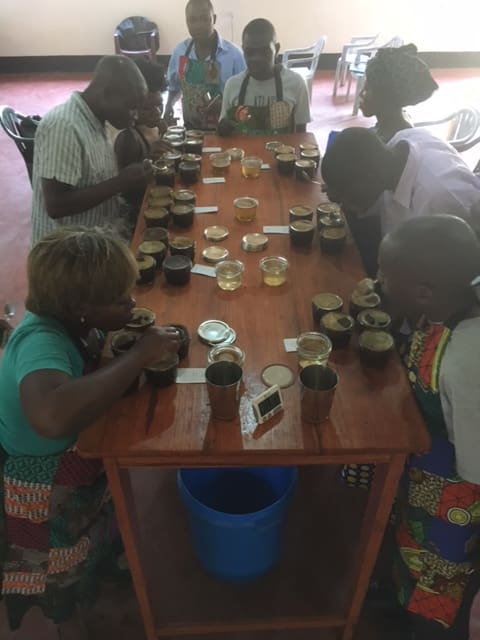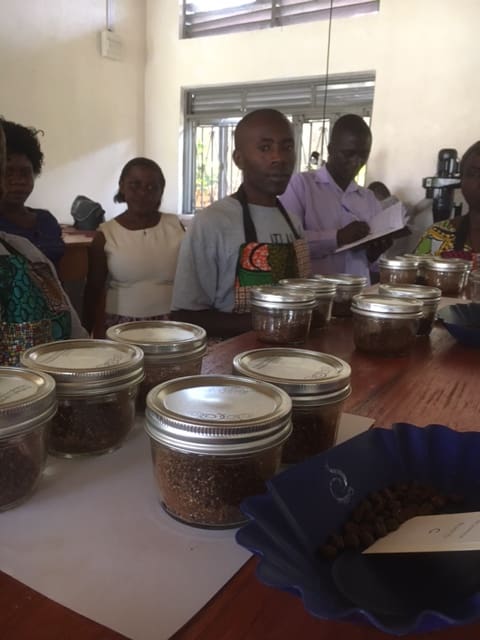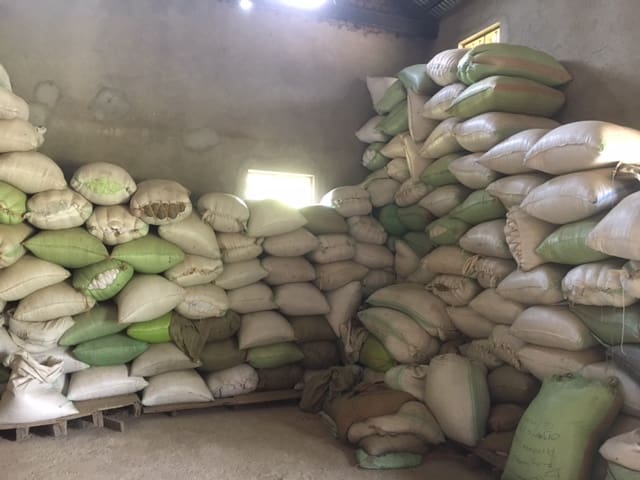In January, Drew & Jen went to visit Bukonzo Joint Cooperative Union in Western Uganda for our Second Annual Cupping Competition and Cupper Training. Atlas Coffee Importers is proud to present Part II of their story...
.
Jen: Welcome back! Drew, let's talk next about why it is important for coffee growers to learn about Quality. What are the benefits to the cooperative?
Drew: I would say that there are three reasons. First, for any kind of trade to work equitably, it is important for buyer and seller to both have access to good information. Doing this kind of quality control training at origin puts more power in the hands of the seller, by giving them the tools to assess the market value of the coffee they are selling. Second, farmers can tend to be disconnected from the end uses of the product that they produce (and I think this is especially true where we work in Uganda) and this makes our encouragement to pursue quality a rather abstract concept. When producers learn to taste quality in brewed coffee, and link that to agricultural practices, it gives concreteness to the goal of quality. Third and finally, having partners at origin who can manage their own QC greatly assists Atlas with efficiency, helps us eliminate defects and other problems early on, and ultimately assists Atlas to be even more successful at procuring great coffee.
Jen: Between the first training a little over a year ago and this one, what really seemed to stick with the students?
Drew: I was quite pleased by how much was retained from my first training. Not only did the students exceed my expectations with how much and how accurately they remembered, it was also clear that the five cuppers from last year had succeeded in passing on the information that they had learned to other trainees. Basic cupping protocols had been internalized and repeatedly used in the intervening year. While we were not able on this trip to focus on sample roasting like I had hoped, it was clear this year that they could easily differentiate by taste between a well-roasted coffee and an improperly roasted coffee.
Jen: One of the things that came up during our conversations with John (one of the cuppers) was that many of the descriptors on the flavor wheel, like blueberries, aren't things that farmers have ever experienced in real life. How important do you think this is in the development of quality analysis skills?
Drew: I don’t think that this presents a significant challenge to them as developing QC professionals. The more important thing is for them to become confident about accurately assessing coffee quality, and for us to continue to calibrate with them over email communication so that we are all assigning coffees similar numerical scores. If they recognize the quality that is sought after by the market, then it really doesn’t matter what flavors or foods they associate with the coffee. In my training sessions I sought to discuss the coffees in terms of descriptors that we have in common, like chocolate, honey, lemon, mango, green vegetables, earth, etc. Ultimately, it would be wonderful if they spent more time tasting and thinking about familiar local products and developed their own culturally relevant cupping descriptors.
Jen: Obviously, there are a lot of challenges in running a competition in rural Uganda, compared to our typical lab experience. Are there any takeaways from this trip that are applicable to your everyday work?
Drew: Really, it just makes me appreciate the fine environment that I get the opportunity to work in on a daily basis – an environment where heating water, grinding coffee, cleaning dishes, and having adequate working light are all available on demand without much effort. As an instructor, this years’ experience was made far superior to my first trip simply because I know what to expect, planned my lessons around the unreliability of electricity, and even then, expected to have disruptions that would call for on the spot adaptations. And I think my experience last year will make me a better instructor at “away game” events because I have realized that I need to plan for flexibility, and always be ready to adapt in real time.
Jen, in your view, what should be the highest priority action items for improving quality at Bukonzo Joint in the short and medium term?
Jen: In the short term, I have two things. First, get more moisture meters out to the washing stations. That’s sort of the easy one, other than finding the money to make it happen, so anyone out there reading this that wants to donate, let us know. Second, we talked a lot during the trip about implementing some new or different protocols around lot separation, milling and sampling, so I think that will be a big improvement even for the coming fly crop.
Medium term, I’d love to work on drying to see if it can be done better. That might mean tweaking the existing drying shed design or we even talked about whether a mechanical dryer might be economically viable.
How about you, Drew? If you could wave a magic wand and make one significant change for the cooperative, what would it be?
Drew: I want to say “drying” but I am going to answer even more broadly and say I would wave my wand to improve infrastructure and systems from the washing stations through to the drying patio. We need to see the development of systems and infrastructure that will remove some risk and create a more durable system capable of regular and repeatable results regardless of circumstances. I would love to see more permanent washing station structures and fermentation tanks, improved drying systems at the washing stations, more efficient means of moving coffee from the washing stations to the mill, improved drying systems at the mill, and improved organization of coffee day lots. Does that qualify as one significant change?
Jen: Yes, I think that qualifies! Follow up question: Since there aren't any magic wands, is that something that is attainable through more traditional means?
Drew: Certainly! I believe this is attainable by non-magical means, but it is a question of where to start and it is also a question of will. These kinds of changes will require a long time frame to unfold and be dependent on buy-in from many different stakeholders. The stakeholders will need to work together to identify priorities, develop a plan, and allocate sufficient resources.
What was your most memorable moment from this year’s trip, Jen?
Jen: Boy, it seems like the whole trip was memorable, but I guess I’d say the awesome party that they threw for us after the presentation of the awards from the competition. I haven’t danced that much in probably 10 years! What about yours?
Drew: At the end of our time there, we held a wrap up meeting with the staff at BJCU to review key things that we had learned, and clearly identify action items to address over the course of the next year. As the meeting was drawing to a close, one of the women cuppers spontaneously broke into a song about the glory of their coffee harvest. This was directly followed by several other songs about coffee, until everyone in the room was singing, clapping, and dancing. What a way to celebrate the week’s efforts and the quality of Bukonzo Joint coffee!



